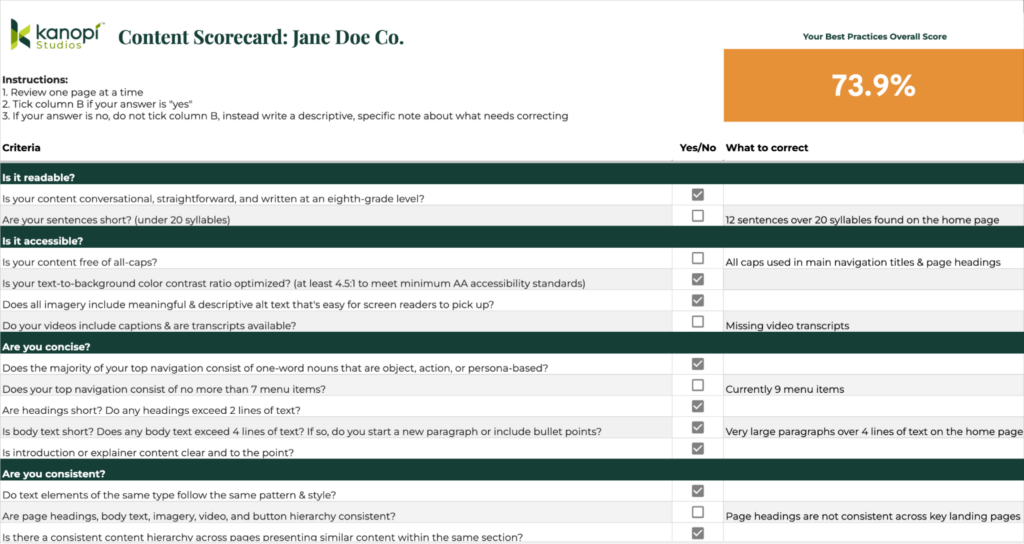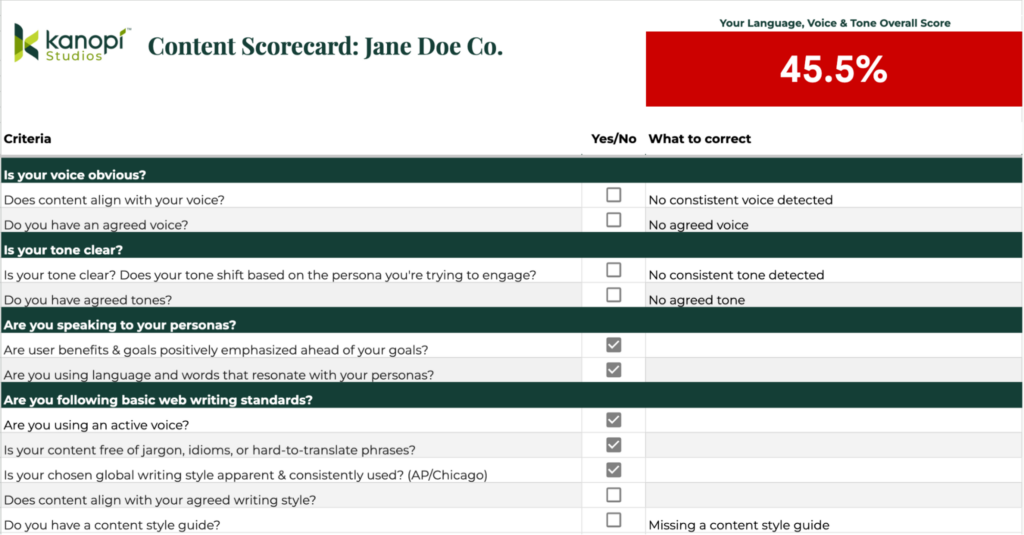Three new websites are built every second.
Let this stat sink in.
That translates to 252,000 new websites created each and every day.
How can you ensure your website’s content is optimized to attract and retain visitors against an ever-increasing number of websites vying for our attention — and that it reaches the coveted top spot on Google’s search engine results page?
At the very least, consider the questions Google asks for creating helpful, reliable, people-first content.
Now, if you really want to take your content to the next level, read on to learn about Kanopi Studios’ Content Scorecard. We’ve built a powerful tool that allows you to evaluate various aspects of your content and identify areas that offer the greatest opportunities for improvement.
Want to skip ahead?
Getting a team excited about a big website redesign is easy. What’s less easy is getting folks excited about a content audit. How do you show a content audit is worth the time and resources? By focusing on the value of completing one.
In this blog, we’ll explore the key metrics of Kanopi’s content scorecard and discuss how it can assist you with auditing the content found on your website, along with the benefits of doing so.
Before we dig into the key metrics, let’s discuss content audits and ROI.
Content audits pinpoint costly problems
Content can expire faster than a carton of milk in your fridge. And if content is no longer helping folks complete key tasks on your site, it could be doing more harm than good.
If any content on your site is actively losing leads, it needs your full attention.
A range of issues impacts your content’s ability to reach and convert your website visitors, including:
- outdated information
- accessibility issues
- confusing or unclear messaging
- non-intuitive website navigation
- poor readability, and
- technical problems like missing metadata.
These challenges can drive website visitors away from your site. Running a content audit can help you find and fix the most prominent issues before they become costly.
Content audits extend the life of existing content
Content audits aren’t just for analyzing your site’s content and finding mistakes. They also discover opportunities to get more out of your existing content.
Content improvement plans tend to surface naturally as a result of content audits. They uncover powerful opportunities to:
- Drive more traffic to your site, improving search engine rankings while beating your competitors to the top spot on Google’s search engine results pages.
- Stand out from the rest, elevating important differentiators to help you overtake your competitors.
- Convert site visitors to patients or customers through increased engagement and conversion optimization.
Numbers always help folks visualize impact. Kanopi audited the Alameda County Community Food Bank’s website content and navigation, using findings to develop a strategy that led to:
- +37% in page views per session and
- 93/100 accessibility score.
Content audits increase the ROI of long-term strategy
Important marketing campaigns need to begin with an informed, data-backed strategy. If you’re about to start a project like a website redesign, begin with a content audit to understand:
- what content you currently have,
- how your content is performing, and
- how to take a holistic approach to improve all site content.
The optimal moment to capture these insights is before you make big changes.
Set yourself up to get the best possible return by setting benchmarks for measuring content performance and how you’ll evaluate success instead of devoting vital resources to something that’ll need fixing later on.
Now, let’s get into Kanopi’s content scorecard metrics used with every content audit we run for our clients:
Content Best Practices
Writing for the web means taking a user-first approach and getting to grips with how people consume content. People aren’t reading your content word-by-word. Instead, folks scan for keywords that help them accomplish the goal of their visit to your website.
Apply these eight proven best practices to ensure your site’s content is actionable and purposeful:
1. Readability
When it comes to your content, readability significantly impacts user engagement.
Simply put, content that‘s easy to read and understand is more likely to resonate with your website visitors.
To evaluate readability, make sure your content is conversational, straightforward, and written at an eighth-grade level. Authoring tools like the Hemingway Editor can help you evaluate the reading level of your content.
Also, you’ll want to ensure that your sentences are short and concise — ideally 20 syllables or less.
2. Accessibility
Ensuring that your content is accessible to all users, including those with disabilities, is not only a legal requirement but also a sound business decision. The World Health Organization estimates that 1 in 6 of us experiences significant disability. Why create unnecessary barriers for folks using your website with inaccessible content?
Check factors such as text-to-background color contrast ratio, meaningful alt text for images, captions for videos, and availability of transcripts.
The WAVE web accessibility evaluation tool provides browser extensions that help you identify which content on your web pages is causing the most challenging accessibility issues.
3. Brevity
In today’s fast-paced digital world, we all have short attention spans, which is why it’s crucial to keep your website’s content concise and to the point.
Save the elaborate prose for that novel you’ve been meaning to write. You can evaluate the brevity of your site’s text-based content by examining factors such as the length of navigation items, headings, body text, and introduction/explainer content.
4. Consistency
Consistency is vital to creating a cohesive and user-friendly experience across your website.
You can assess consistency by checking if text elements follow the same pattern and style, if there is a consistent content hierarchy across pages familiar to folks, and if navigation pathways are logical and easy to follow.

5. Clear Pathways
Your content should guide users along a clear path down every page and across to related pages on your site, leading them to the next desired action.
Check that the next desired action you want folks to take is clearly stated on the page, that the page is organized logically, and navigation pathways are easy to find and follow. Prominent breadcrumbs help people keep track of where they are within the content on your site.
6. Accuracy
Ensuring that your content is accurate and up to date is essential for maintaining credibility and trust with your website visitors.
Evaluate accuracy by checking for outdated information and verifying that content has been fact-checked by one of your subject-matter experts.
7. Narrative Progression
Effective storytelling can captivate your audience and keep them engaged with your content.
Assess your narrative progression by checking if content flows logically from the top of each page to the bottom, providing users with a cohesive and engaging experience. Headings, subheadings, body text, and buttons should relate to each other and guide folks to easily move down each web page.
8. Telling your story
Every piece of content on your site should serve a purpose and contribute to your overarching narrative. Every word, image, video, and graphic should relate to each other and help you tell your organization’s story.
Evaluate your storytelling chops by checking if text complements images, illustrations, and videos and if it’s clear how each piece of content contributes to telling your story.
Language, Voice, & Tone
Determining the right voice and tone — and which words to use to convey your voice and tone — is essential to engaging your site visitors and creating a connection with them.
Different content warrants a shifting tone (e.g., if you’re discussing cancer treatment options it’s best not to be too light), but generally speaking, aim for a personal, positive tone when writing content.
Strike the right balance between appearing casual with your readers while avoiding bureaucratic or institutional speak. Your writing should sound like it is coming from a human, not a corporate robot. ‘Write like you talk’ is a helpful phrase to remember to ensure your writing isn’t too stiff.
Getting your tone right can be tricky, but studies show it dramatically impacts your user’s perception of your organization. Here are four key points to remember:
1. Your Voice
Your organization’s voice is its personality — it sets the tone for communicating with your website visitors.
Assess your voice by checking if content aligns with your brand’s voice, and if it’s consistent across your site. (If you don’t have written guidelines in place describing your brand voice, we’d strongly recommend you start there.)
2. Your Tone
The tone of your content can vary depending on the audience you’re trying to reach and the message you’re trying to convey.
Evaluate your tone by checking if it’s clear, consistent, and resonates with your target personas.

3. Persona Alignment
Tailoring your content to resonate with your target personas is essential for connecting with the people who matter most to your organization.
Evaluate persona alignment by checking that your content emphasizes user benefits and goals and if the language and words on your site resonate with the people who visit it daily.
What is a persona, you ask? Personas are archetypical users whose characteristics and goals represent the needs of a larger group of your audience. Learn more about how personas help with web design.
4. Web Writing Standards
Adhering to basic web writing standards can improve the clarity and effectiveness of your content.
Check your content uses an active voice, avoids jargon and idioms, follows a consistent writing style, and aligns with your agreed content style guide.
Search Engine Optimization (SEO)
There’s no denying that optimizing your content for SEO impacts your content’s performance and helps you meet important marketing goals.
Without it, your organization could be missing out on organic traffic, leads, sales, visibility, and rankings. Zero in on your keywords, meta descriptions, and alt text to get the most out of your existing content:
1. Keyword Optimization
Optimizing your content for relevant keywords can improve its visibility in search engine results.
Achieve basic keyword optimization by checking if target keywords are present and appear naturally throughout each page within headings, subheadings, body text, and buttons (as opposed to throwing them in without considering their proper context, a.k.a. ‘shoehorning’).
2. Meta Description Optimization
Meta descriptions play a crucial role in attracting clicks from folks using search engines to find what they need. Evaluate your meta descriptions by checking if they’re under 155 characters, use an active voice, match the content on the page, are unique, and include target keywords.

3. Alt Text Optimization
Alt text is essential for providing context to users who cannot view images.
Review your site’s alt text by making sure it’s specific succinct, and correctly applied to relevant images. Also, ensure all images have unique alt text. Duplicate alt text can confuse folks who use a screen reader when exploring your site.
Check out our webinar on SEO.
A must-attend webinar for business owners, marketers, and anyone looking to make SEO work smarter, not harder. Lauren Chervinski gave a webinar focused on SEO called “SEO Survival Kit: 5 Steps to Thrive Now and in the AI Era .” (47 minutes)
Ensure your content is readable, accessible, SEO optimized (and more!)
By closely examining your content to ensure it follows best practices, you can pinpoint areas that need improvement and make sure your content is engaging, accessible, and optimized for both visitors and search engines like Google.
By conducting regular content audits using Kanopi’s content scorecard, you can maintain high-quality content standards and ensure that all the content on your website tells your unique story.
If you need help with your next content audit, don’t hesitate to get in touch with Kanopi. We’re more than happy to help you get started.
Contact us to help you run a content audit (or download our content scorecard template for yourself).










